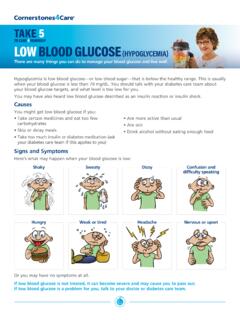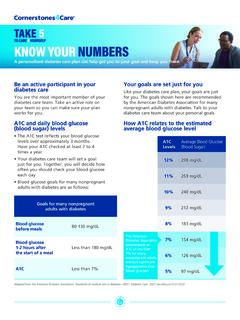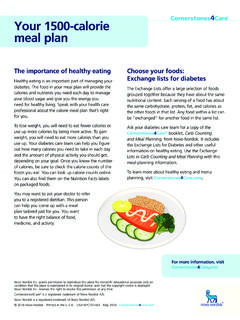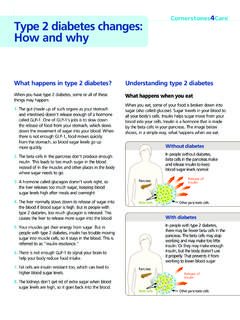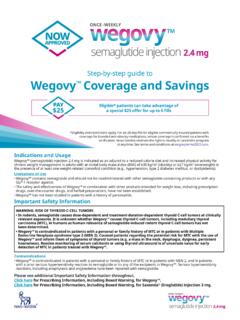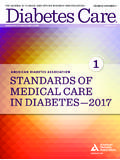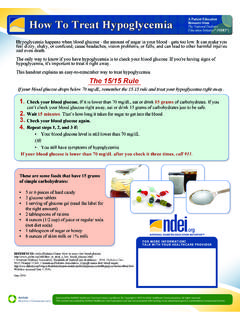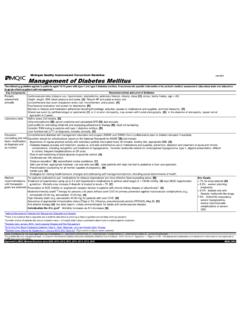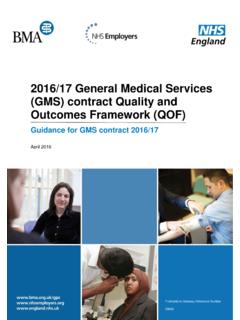Transcription of What is diabetes? - NovoMedLink
1 what happens in diabetes ? diabetes is a condition in which the body doesn t make or use insulin correctly. The image below shows, in a simple way, what happens normally when you people without diabetes :n When you eat, some of your food is broken down into sugar (also called glucose). Sugar travels in your blood to all your body s cells. Your cells need sugar for energy. Sugar from food makes your blood sugar level go upn In response to increased sugar, beta cells in the pancreas release a hormone called insulin. Insulin is like a key that unlocks the doors of your cells so that sugar can get into the cells, where it is used as a source of energyn There are other hormones that play important roles in how the body uses sugar. For example, amylin and GLP-1 help reduce the amount of sugar made by the liver and slow the emptying of food from the stomach.
2 Another hormone called glucagon tells the liver to release stored sugar if your blood sugar gets too low or if you have not eaten for many hours, such as overnight If you or someone you know has diabetes , you re not alone. Millions of people have diabetes . diabetes cannot yet be cured. But it can be most common types of diabetes are type 1 and type 2 The information below focuses on type 2 diabetes . For more information about type 1 diabetes , visit 2In type 2 diabetes , your body prevents the insulin it does make from working right. Or it may not make enough insulin. Most people with diabetes have type 2. Some risk factors for this kind of diabetes include older age, being overweight or obese, family history, and having certain ethnic backgrounds. Type 1In type 1 diabetes , the body makes little or no insulin, due to an overactive autoimmune system.
3 So people with type 1 diabetes must take insulin every day. Type 1 diabetes usually occurs in children and young adults, but it can also appear in older adults. (An autoimmune disease means that the body attacks its own cells by mistake.)FoodHormones (like GLP-1) Pancreatic beta cells (release insulin and amylin)InsulinDigestionBlood sugarCellsWhat is diabetes ?Distributed in collaboration with Account Xplace logo hereWhat happens in diabetes ? diabetes is a condition in which the body doesn t make or use insulin correctly. The image below shows, in a simple way, what happens normally when you people without diabetes :n When you eat, some of your food is broken down into sugar (also called glucose). Sugar travels in your blood to all your body s cells. Your cells need sugar for energy. Sugar from food makes your blood sugar level go upn In response to increased sugar, beta cells in the pancreas release a hormone called insulin.
4 Insulin is like a key that unlocks the doors of your cells so that sugar can get into the cells, where it is used as a source of energyn There are other hormones that play important roles in how the body uses sugar. For example, amylin and GLP-1 help reduce the amount of sugar made by the liver and slow the emptying of food from the stomach. Another hormone called glucagon tells the liver to release stored sugar if your blood sugar gets too low or if you have not eaten for many hours, such as overnight If you or someone you know has diabetes , you re not alone. Millions of people have diabetes . diabetes cannot yet be cured. But it can be most common types of diabetes are type 1 and type 2 The information below focuses on type 2 diabetes . For more information about type 1 diabetes , visit 2In type 2 diabetes , your body prevents the insulin it does make from working right.
5 Or it may not make enough insulin. Most people with diabetes have type 2. Some risk factors for this kind of diabetes include older age, being overweight or obese, family history, and having certain ethnic backgrounds. Type 1In type 1 diabetes , the body makes little or no insulin, due to an overactive autoimmune system. So people with type 1 diabetes must take insulin every day. Type 1 diabetes usually occurs in children and young adults, but it can also appear in older adults. (An autoimmune disease means that the body attacks its own cells by mistake.) what is diabetes ? what is diabetes ?Knowing your A1 CThe A1C test measures your estimated average blood sugar level over the past 2 to 3 months. It s like a memory of your blood sugar levels. It shows how well you re controlling your blood sugar levels over A1C is made up of 2 other blood sugar measurements:n FPG is your fasting plasma glucose.
6 This is your blood sugar number when you have been fasting (not eating) for at least 8 hoursn PPG is your postprandial plasma glucose. This is your after-meal blood sugar level, which you check about 1 to 2 hours after you eat. It measures the blood sugar spikes that happen after you eatBoth your FPG and your PPG have to be at their targets in order for your A1C to be at A1C and your blood sugar levels go up and down together. Here is how A1C relates to the estimated average blood sugar level:In people with diabetes :n Your pancreas makes little or no insulin, orn Your body prevents the insulin you do make from working right. This is called insulin resistanceChecking your blood sugarChecking your blood sugar yourself can be an important part of a diabetes care plan. Checking often will tell you:n If your insulin or other diabetes medicine is workingn How physical activity, the foods you eat, and stress affect your blood sugarYou ll usually feel better and have more energy when your blood sugar stays at or near your goal.
7 Managing your blood sugar can also reduce your risk of developing problems from levelsAverage blood sugar6%126 mg/dL7%154 mg/dL8%183 mg/dL9%212 mg/dL10%240 mg/dL11%269 mg/dL12%298 mg/dLAdapted from the American diabetes Association. Standards of medical care in diabetes 2016. diabetes Care. 2016;39(suppl 1):S1-S112It is recommended that you get an A1C test:n At least 2 times a year if your blood sugar is under good controln 4 times a year if you re not meeting your goals or if your treatment has changedAccording to the American diabetes Association, lowering your A1C to below 7% may reduce your risk of some diabetes -related problems, like problems with your nerves, eyes, and kidneys. Your health care provider will tell you what your personal A1C goal should to check your blood sugarYou and your diabetes care team will decide when and how often you should check your blood sugar.
8 Here are some times when you may want to check:n At bedtime and when you wake up, to see if your blood sugar is staying under control while you re asleepn Before meals or large snacks, to know what your blood sugar is before you eatn 1 to 2 hours after meals, to see how the food you eat affects your blood sugarn Before and within minutes after physical activity, to see how being active affects your blood sugarDepending on the medicine you re taking, your health care professional may want you to check your blood sugar more or less often. Talk with him or her about how often and when you should be to check your blood sugar and keep track of your numbersMany different kinds of blood sugar meters are available today. Your diabetes care team can help you choose a meter and show you how to use it.
9 It s important to write down your blood sugar levels so that you can keep track of what makes them go up or down. Some meters also keep a log of your past blood sugar levels. You can also ask your diabetes care team for a copy of the Cornerstones4 Care booklet Staying on Track. Or go to for an online with your diabetes care team about your A1C goal and write it here: _____Open hereIf your doctor wants you to adjust your mealtime insulin. Use this section based on your doctor s diabetes changes over time, your doctor may decide to add mealtime insulin to your plan to help control blood sugar when you eat. There are many ways to add mealtime insulin to your care plan. Together, your doctor and you will decide on the insulin plan that is right for and your doctor can use the example under this flap to see how you might add mealtime insulin one meal at a time.
10 Adding or starting mealtime insulin55 Novo Nordisk Inc. grants permission to reproduce this piece for nonprofit educational purposes only, on condition that the piece is maintained in its original format and that the copyright notice is displayed. Novo Nordisk Inc. reserves the right to revoke this permission at any time. The photographs used in this booklet are for illustration only. The models in the photographs do not necessarily have diabetes or other is a registered trademark of Novo Nordisk Nordisk is a registered trademark of Novo Nordisk A/S. 2016 Novo Nordisk Printed in the 0615-00027363-1 February 2016 order additional trackers, please call you ve received this tracker without the Staying on Track booklet, you can ask your diabetes care team for the booklet.
